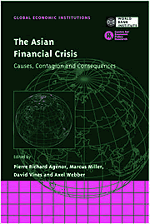Book contents
- Frontmatter
- Contents
- List of figures
- List of tables
- Preface
- List of conference participants
- Acknowledgements
- List of abbreviations and acronyms
- Introduction
- Part One General Accounts
- 1 The role of macroeconomic and financial sector linkages in East Asia's financial crisis
- Discussion
- 2 The Asian crisis: lessons from the collapse of financial systems, exchange rates and macroeconomic policy
- Discussion
- 3 Are capital inflows to developing countries a vote for or against economic policy reforms?
- Discussion
- 4 The Asian crisis: an overview of the empirical evidence and policy debate
- Discussion
- Part Two Theoretical Contributions
- Part Three Contagion
- Part Four Policy Responses
- Index
4 - The Asian crisis: an overview of the empirical evidence and policy debate
from Part One - General Accounts
Published online by Cambridge University Press: 26 February 2010
- Frontmatter
- Contents
- List of figures
- List of tables
- Preface
- List of conference participants
- Acknowledgements
- List of abbreviations and acronyms
- Introduction
- Part One General Accounts
- 1 The role of macroeconomic and financial sector linkages in East Asia's financial crisis
- Discussion
- 2 The Asian crisis: lessons from the collapse of financial systems, exchange rates and macroeconomic policy
- Discussion
- 3 Are capital inflows to developing countries a vote for or against economic policy reforms?
- Discussion
- 4 The Asian crisis: an overview of the empirical evidence and policy debate
- Discussion
- Part Two Theoretical Contributions
- Part Three Contagion
- Part Four Policy Responses
- Index
Summary
Introduction
Was the Asian crisis caused by fundamental weaknesses and policy mistakes, or was it due to a financial ‘panic’ (encompassing phenomena such as ‘fickle investors’, volatile hot money, multiple instantaneous equilibria, speculative capital flights and bank runs)? An analysis of the causes of the crisis is important because, depending on one's view, conclusions may differ as regards what could have been done differently to prevent the crisis and its global contagion, and what can be done in the future to reduce the risk of financial turmoil.
Yet, the two ‘views’ of the crisis are not completely inconsistent with each other. On the one hand, the possibility of multiple instantaneous equilibria – underlying interpretations based on self-fulfilling attacks – arises only when economic fundamentals are ‘weak enough’ – i.e. some deterioration of fundamentals is a necessary condition preceding a panic. On the other hand, the view that the crisis is initially triggered by fundamental factors does not necessarily rule out the possibility that, after the crisis, movements of asset prices (exchange rates and stock market indexes) and capital flow reversals may be excessive and not warranted by fundamentals.
Challenging the readings of the 1997–8 events that downplay the role of structural factors, in the first part of this chapter we attempt to document the extent to which the Asian crisis was related to fundamental imbalances. We argue that, beneath apparently strong economic performances (low budget deficits, low public debt/GDP ratios, single-digit inflation rates, high economic growth and high savings and investment rates) lay institutional weaknesses, policy inconsistencies and severe structural distortions.
- Type
- Chapter
- Information
- The Asian Financial CrisisCauses, Contagion and Consequences, pp. 127 - 163Publisher: Cambridge University PressPrint publication year: 1999
- 10
- Cited by



